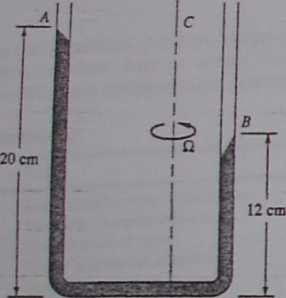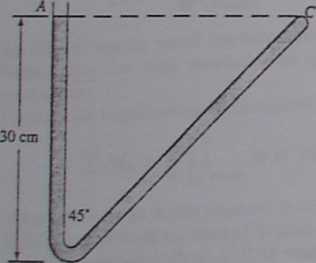DSC03091
*
jrr Distnbutioo in a Fluid
3.1*

10cm
'5 cm
i
Comptue the ńetd-body rotadon ratę about its central axis. in r min, (u) for which one-third of the water wili spili out and {b t for which the bonom will be barely exposed.
2.153 Suppose the U-tube in Fig. P2.I50 is not translated but noher totated about its right leg at 95 r/min. What will be the level h in the left leg if L gg 18 cm and D = 5 mm?
. .154 A very deep 18-cm-diameter can eon tai ns 12 cm of water overlaid with 10 cm of SAE 30 oil. If the eon is rotated in rigid-body modon about its central axis at 150 r/min, what will be the shapes of the air-oil and oil-water interfaces? What will be the maximura fluid pressure in the can in Pa (gage)?
2.155 For what uniform rotadon ratę in r/min about axis C will the U-tube in Fig. P2.155 take the configuration show n? The fluid is mercury at 20°C.
Fig. P2.155
2.156 Suppose that the U-tube of Fig. P2.151 is rotated about axis DC. If the fluid is water at 122°F and atmospheric pressure is 2116 lbf/fr absolute, at what rotadon ratę will the fluid whhin the tubę begin to vaporize? At what point will this occur?

B
Fig. P2.157
2.157 The 45* V-tube in Fig. P2.157 contains water and is open at A and closed at C. What uniform rotadon ratę in r/min about axis AB will cause the pressure to be equal at points B and C? For this condition, at what point in leg BC will the pressure be a minimum?
Word Problems
W2.1 Consider a hollow cone with a vent hole in the vertex at the top. along with a hollow cylinder, open at the top, with the same base area as the cone. Fili both with water to the top. The hydrostatic paradox is that both containers bave the same fotce on the bottom due to the water pressure. although the cone contains 67 percent less water. Can you explain the paradox?
Vtl2 Can the temperaturę ever rise with aldtude in the real at-mosphere? Wouldn‘t this cause the air pressure to inerease upward? Explain the physics of this situadon.
W23 Consider a submerged curved surface which consists of a two-dimensional circular arc of arbitrary angle, arbitrary depth, and arbitrary orientadon. Show that the resultant hydrostatic pressure fotce on this surface must pass through the center of curvature of the arc.
W2.4 Fili a glass approximately 80 percent with water. and add a large i cc cube. Mark the water level. The ice cube, having SG ** 0.9. sdeks up out of the water. Let the ice cube melt with negiigible evaporadon from the water surface. Will the water Ievel be higher than. lower than, or the same as before?
W2J A ship, canying a load of Steel, is trapped while floadng in a smali closed lock. Members of the crew want to get out, but tbey can't quite reach the top wali of the lock. A crew member suggests throwing the Steel overboard in the lock, daiming the ship will then rise and they can dimb out. Will this plan work?
W2.6 Consider a balloon of mass m floadng neutrally in the at-mosphere, carrying a person/basket of mass M>m. Discuss the stabOity of this system to disturbances.
W2.7 Consider a helium balloon on a string ded to the seat of your stadonary car. The Windows are closed, so there is no air mouon within the car. The car begins to accelerate forward. Which way will the balloon lean, forward or baekward? (Hitu: The acceleration sets up a horizontal pressure gradient in the air within the car.)
W2JJ Repeat your analysis of Prób. W2.7 to let the car move at constant velocity and go around a curve. Will the balloon lean in. toward the center of curvature, or out?
1

Problcms 109
Design Project
D2.1 It is desircd to have a bottom-moored. floating system which creates a nonlinear force in the mooring linę as the water ]evel rises. The design force F need only be accurate in the rangę of seawater depths h between 6 and 8 m. as shown in the accompanying table. Design a buoyant system which will provide this force distribution. The system should be prac-tical. i.e.. of inexpensive materials and simple construction.
k
|
h, m |
F, N |
h, m |
F.N |
|
6.00 |
400 |
7.25 |
554 |
|
6.25 |
437 |
730 |
573 |
|
630 |
471 |
7.75 |
589 |
|
6.75 |
502 |
8.00 |
600 |
|
7.00 |
530 |
Wyszukiwarka
Podobne podstrony:
DSC03088 .« Pirssure Distribution in a Fluid 2.-U)>. What diameter of the sphere is just sufficie
DSC03086 :w;Tv Distribuiion in j Fluid Find tr»c anilinie u w huh the pressure deviation is (u) I t
DSC03089 PresMłrt DisłnNjocc in a Fluid Fig. P2JS4 atmospberic pressure, and let tbe surfacc hm unit
DSC03090 ‘*ł Pressure Distribuooo in a Fluid Fig. P2.99 atmospherfc pressure. compute the hydrostati
DSC03087 & . II-I. i.. — Xj Pressure Dismbution in a Fluid 1
F00574 017 f020 Jugular venous pressure raised in fluid overload or pericardial tamponade Pulsu
F00574 017 g001 Fundoscopy Hypertensive changesA Jugular vcnous pressure Elevated in fluid overload
50 Fluid Mechanics connected to the pipę, due to high pressure at A, the heavy !iquid in the reservo
swoją ściągę o wymiarach 10cm x 3,2 cm. Dzięki temu podczas pisania całą ściągę masz ciągle przed
6 (887) AntidiarrhealsDiarrhoea Diarrhoea involves either an increase in fluid secretion into the gu
90 (63) H fi Faith Yarn: D.M.C. No. 20 Size: Height 5-5 cm. (2£ in.) circumference 26 cm. (10£ in.)
Pod specjalną, półprzezroczystą osłonką umieszczasz swoją ściągę o wymiarach 10cm x 3,2 cm. Dzięki
Seite6 7 Auf dem Pautrnhcf o Tonkarton in Rosa o 6 Perlen in Weift, 0 0,7 cm o Papierdraht in W
Jak to działa? swoją ściągę o wymiarach 10cm x 3,2 cm. Dzięki temu podczas pisania całą ściągę masz
img060 (19) NOTES ♦ Work all inereases and decreases one stitch in from edges. .5) cm g *3 3V4i4,4
gleby450 Starą Słupia. Pole pod pszenicą. F. Kuźnicki i in. Ap 0—20 cm — utwór pyłowy zwykły, barwy
248 (47) r-- o in en en CM •D c o soo <3 Z. Jamroły. /)r;nti < xvAm>b);ie. Wir5W#u 2005 ISB
więcej podobnych podstron